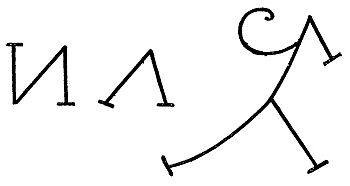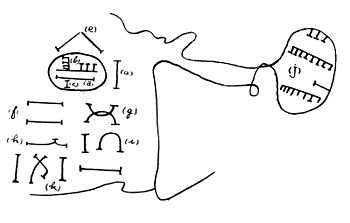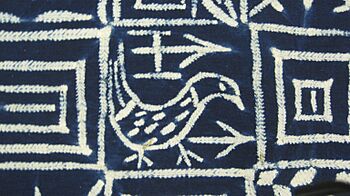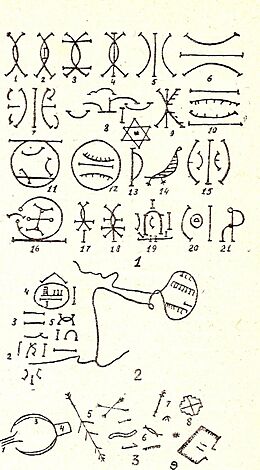Nsibidi facts for kids
Quick facts for kids Nsibidi |
|
|---|---|

A symbol simply described as "Nsibidi name written" by Elphinstone Dayrell in 1911.
|
|
| Type | Ideographic |
| Spoken languages | Ekoid, Efik, Ibibio, Igbo |
| Time period | circa 400 AD – present |
| Child systems | anaforuana (Cuba), veve (Haiti), “Neo-Nsibidi” (Nigeria), “Akagu” (Nigeria) |
| Note: This page may contain IPA phonetic symbols in Unicode. | |
Nsibidi (also known as Nsibiri, Nchibiddi or Nchibiddy) is a system of symbols or proto-writing developed by the Ekpe secret society that traversed the southeastern part of Nigeria. They are classified as pictograms, though there have been suggestions that some are logograms or syllabograms.
Use of the symbol system was first discovered in 1904. Excavation of terracotta vessels, headrests, and anthropomorphic figurines from the Calabar region of southeast Nigeria, dated to roughly the 5th to 15th centuries, revealed "an iconography readily comparable" to nsibidi.
There are several hundred Nsibidi symbols. They were once taught in a school to children. Many of the signs deal with love affairs; those that deal with warfare and the sacred are kept secret. Nsibidi is used on wall designs, calabashes, metals (such as bronze), leaves, swords, and tattoos. It is primarily used by the Ekpe leopard society (also known as Ngbe or Egbo), a secret society that is found across old Cross River region among the Igbo, Ekoi, Efik, Bahumono, and other nearby peoples.
Before the colonial era of Nigerian history, Nsibidi was divided into a sacred version and a public, more decorative version which could be used by women. Nsibidi was and is still a means of transmitting Ekpe symbolism. Nsibidi was transported to Cuba and Haiti via the Atlantic slave trade, where it developed into the anaforuana and veve symbols.
History
Robert Farris Thompson glosses the Ekoid word nsibidi as translating to "cruel letters", from sibi "bloodthirsty". In old Cross River region, Nsibidi is mostly associated with men's Ekpe society. The Ekpe societies were a legislative, judicial, and executive power before colonisation in parts of Aro Confederacy, including Igbos, Efik, Ibibios who exerted much influence over the old Cross River region, located in today's Nigeria.
Origin
The origin of Nsibidi is now generally attributed to the Ekoi or Ejagham people of the Northern Cross River, though in the 1900s J. K. Macgregor recorded a native tradition attributing it to the Uguakima or Uyanga section of the Igbo people. However, the Nsibidi of the Ejagham people predates Macgregor's stay in the area and he may have been misled by his informants. A few years later, the anthropologist Percy Amaury Talbot was unable to verify the tradition recorded by Macgregor and concluded that the claims of the Ekoi to have created the system were more plausible.
Status
Nsibidi has a wide vocabulary of signs usually imprinted on calabashes, brass ware, textiles, wood sculptures, masquerade costumes, buildings and on human skin. Nsibidi has been described as a "fluid system" of communication consisting of hundreds of abstract and pictographic signs. In the colonial era, Nsibidi was characterized by Talbot as "a kind of primitive secret writing", with Talbot explaining that it was used for messages "cut or painted on split palm stems". Macgregor's view was that "The use of nsibidi is that of ordinary writing. I have in my possession a copy of the record of a court case from a town of Enion [Enyong] taken down in it, and every detail ... is most graphically described". Nsibidi crossed ethnic lines and was a uniting factor among ethnic groups in the Cross River region.
Uses
Nsibidi spread to other parts of Nigeria, especially the Igbos, who are neighbors to the old Calabar people (the Efik, Ibibio and Annang).
Court cases – "Ikpe"
Nsibidi was used in judgement cases known as 'Ikpe' in Enion, an Igbo subgroup, according to Macgregor, who was able to retrieve and translate an Nsibidi record of an ikpe judgement.
Ukara Ekpe
Nsibidi is used to design the 'ukara ekpe' woven material which is usually dyed blue (but also green and red) and is covered in Nsibidi symbols and motifs. Ukara ekpe cloths are woven in Abakaliki, and then they are designed by male Nsibidi artists in the Igbo-speaking towns of Abiriba, Arochukwu and Ohafia to be worn by members of the Ekpe society. Symbols including lovers, metal rods, trees, feathers, hands in friendship war and work, masks, moons, and stars are dyed onto ukara cloths. The cloth is dyed by post-menopausal women in secret, and young males in public. Ukara was a symbol of wealth and power only handled by titled men and post-menopausal women.
Ukara can be worn as a wrapper (a piece of clothing) on formal occasions, and larger version are hung in society meeting houses and on formal occasions. Ukara motifs are designed in white and are placed on grids set against an indigo background. Some of the designs include abstract symbols representing the Ekpe society such as repeating triangles representing the leopard's claws and therefore Ekpe's power. Ukara includes naturalistic designs representing objects such as gongs, feathers and manilla currency, a symbol of wealth. Powerful animals are included, specifically the leopard and crocodile.
Examples of Nsibidi
Below are some examples of Nsibidi recorded by J. K. Macgregor (1909) and Elphinstone Dayrell (1910 and 1911) for The Journal of the Royal Anthropological Institute of Great Britain and Ireland and Man. Both of them recorded symbols from a variety of locations around the Cross River, and especially the Ikom district in what is now Cross River State. Both of the writers used informants to retrieve Nsibidi that were regarded as secret and visited several Cross River communities.
See also
- Writing systems of Africa
- Africa Alphabet
- African reference alphabet






